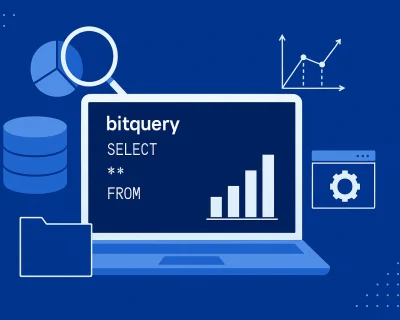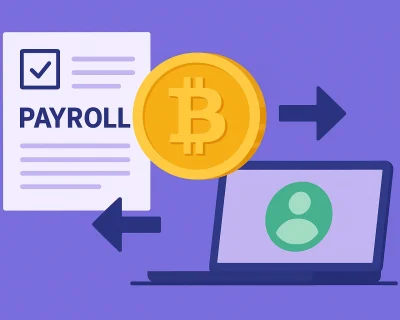Unlocking the Power of Decentralization! How to Create a Smart Contract?
Table of contents
- Step 1. Access the Remix IDE and Create a New File
- Step 2. Copy and Paste the Provided Code
- Step 3. Compile the Ethereum Smart Contract
- Step 4. Connect Your MetaMask to Remix IDE
- Step 5. Deploy Your Own Smart Contract
- What is a Smart Contract?
- Types of Smart Contracts and Capabilities
- What Smart Contract Platforms are Available in Crypto?
- FAQ
- Last Thoughts
Are you tired of struggling with the traditional way of processing a transaction or a contract that comes with a lack of transparency, intermediaries, risk of fraud and tampering, absence of flexibility, and costly fees, besides the insufficiency of real-time updates? We’ve got you!
If you are wondering whether to create a smart contract, in today’s article, we will discuss all the necessary details surrounding self-executing contracts, and by the end, you will learn how to create your first smart contract.
Also, if you want to learn more about decentralized finance in 2024, remember to check our latest blog article, where we discuss how DeFi (Decentralized Finance) works, the pros and cons, and the trends that matter so you can make an informed decision over your digital assets.
Step-by-Step: How to Create a Smart Contract?
To get right into what you’re interested in, let’s start with a guide on creating and deploying a smart contract. If you feel like you need more background on what exactly a smart contract does and its capabilities, you can jump to the second part of this article and then resume the creation process.
Since Ethereum is where most smart contracts are made, we’ll focus on creating and deploying a simple smart contract on the Ethereum network. We’ll use Remix, which is a browser-based IDE for developing Ethereum smart contracts. With Remix, you won’t need any extra tools or software, just a crypto wallet.
So, let’s get going!
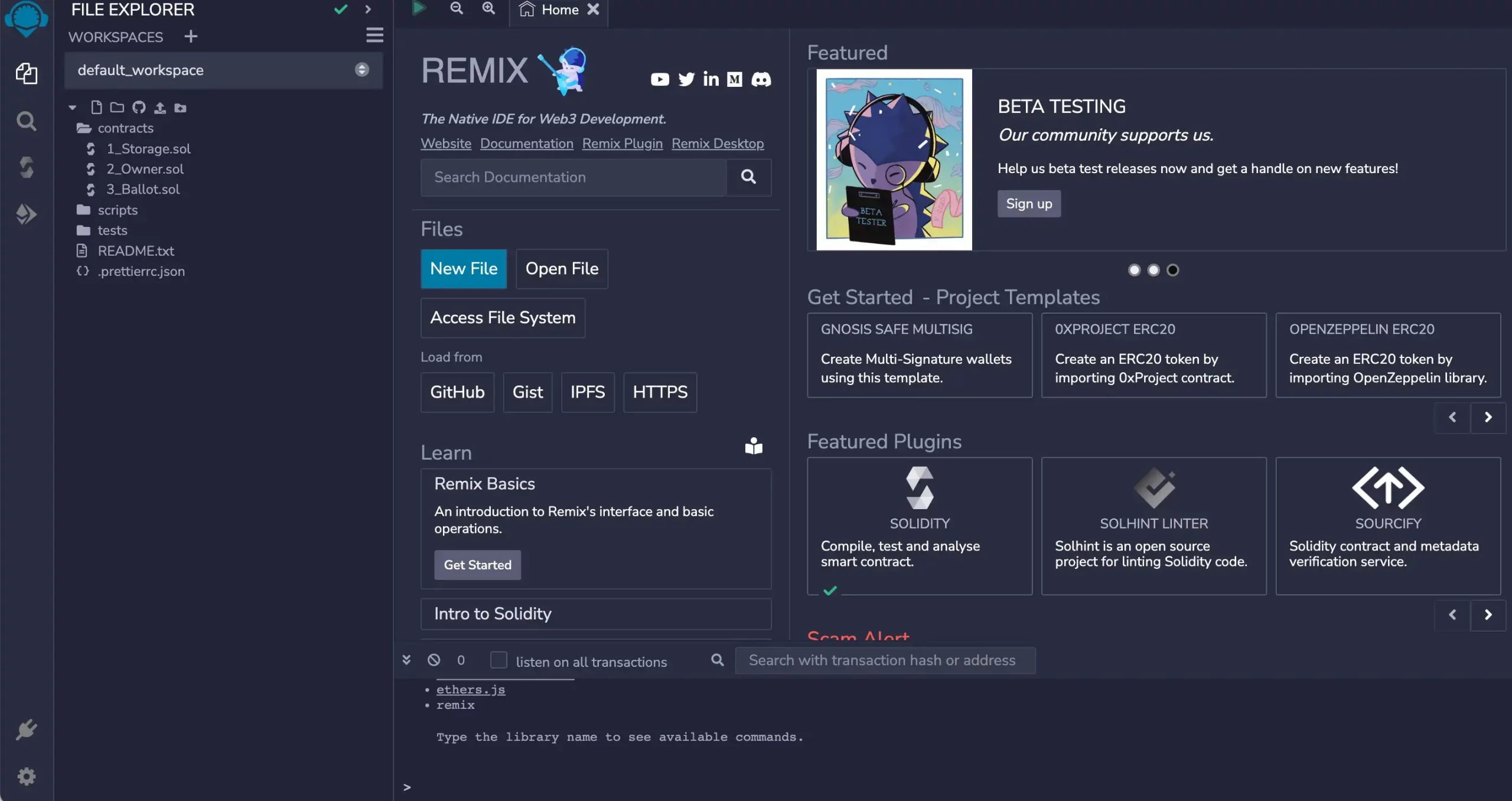
Step 1. Access the Remix IDE and Create a New File
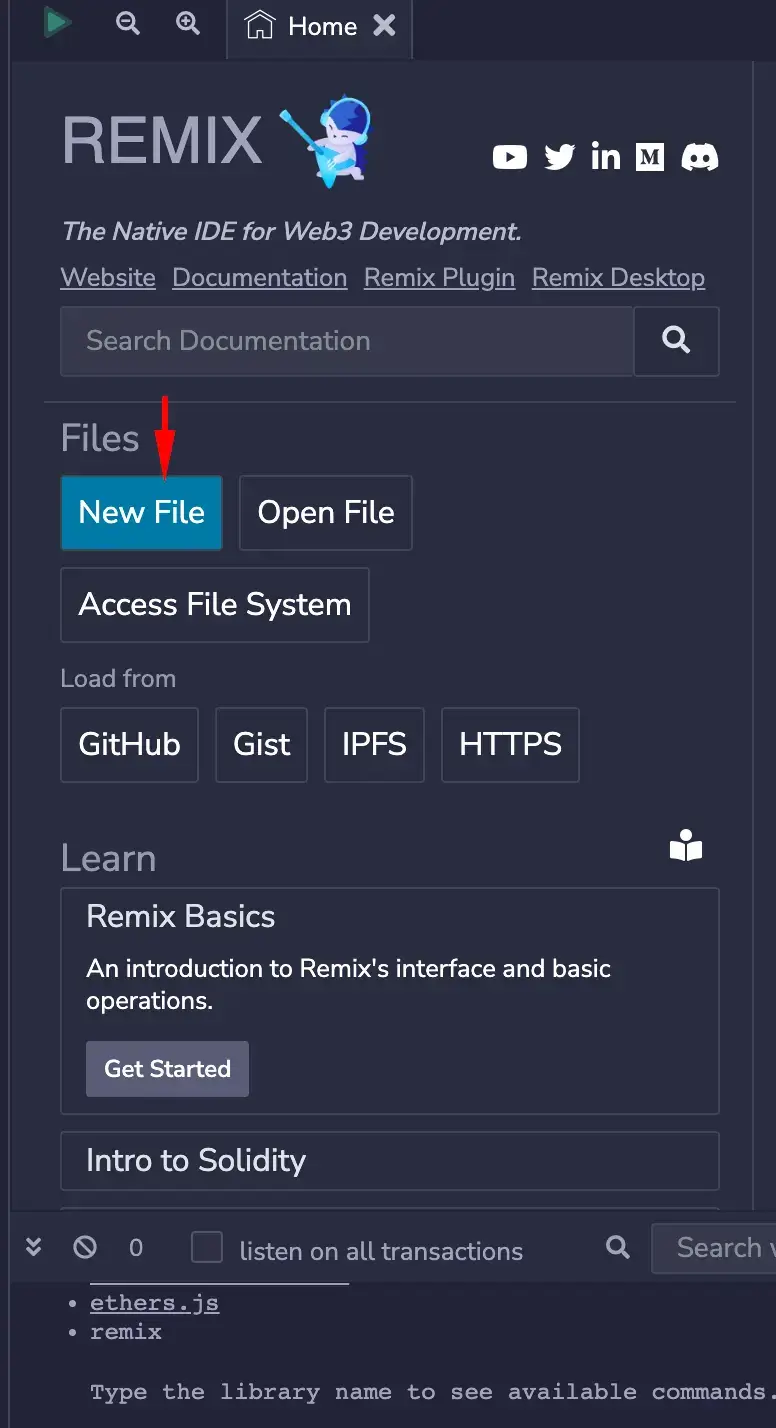
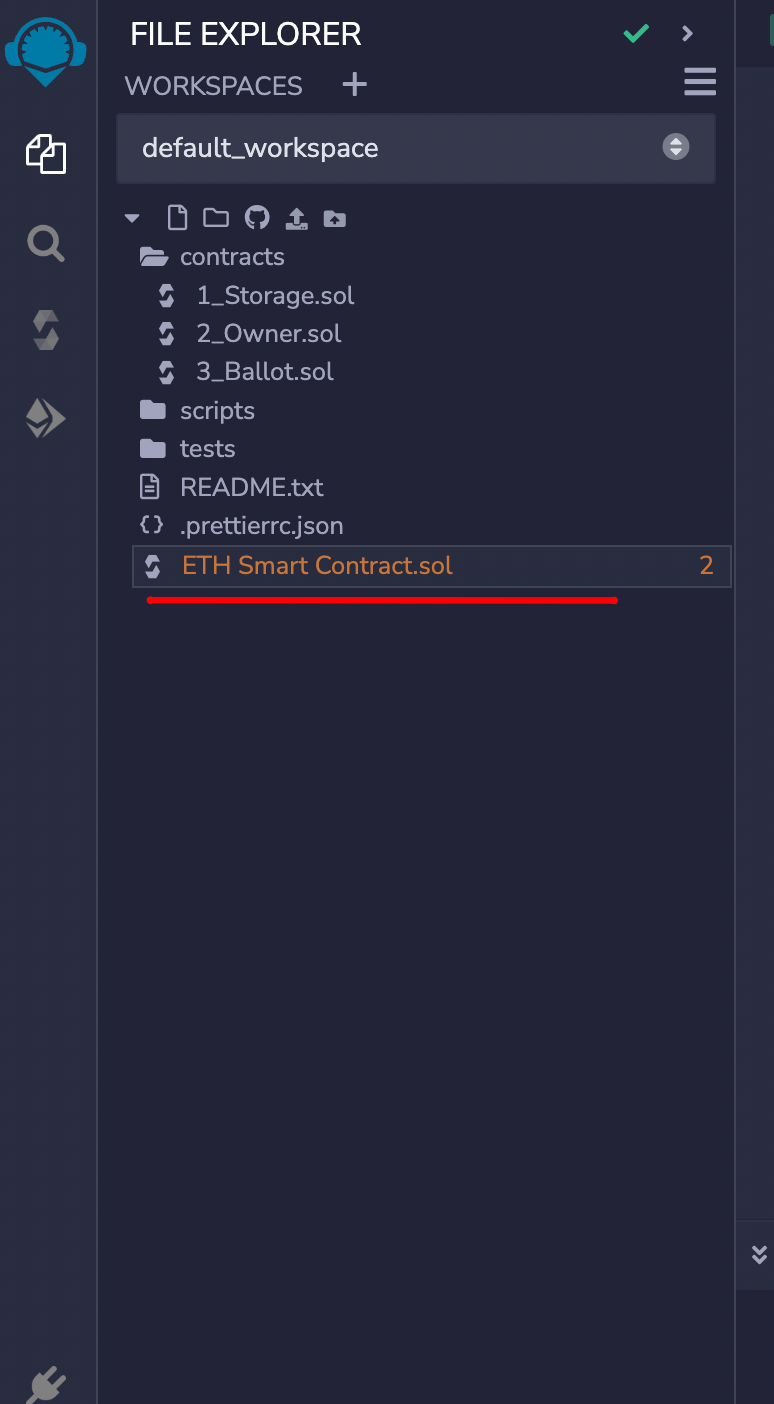
Before you start writing your smart contract code, you must prepare your development environment.
Begin by opening Remix-IDE in your web browser. Once you’re in the Remix-IDE interface, find and click on the “Contracts” tab on the left side of the screen.
Under the default_workshop, you’ll see the “File” icon. Click on it, and then create a new file where you can write your smart contract code.
You’ll need to give your file a name. Let’s call it “ETH Smart Contract” for this example. Once you’ve named your file, you’ll see an empty code editor in the Main Panel, along with a tab displaying your file’s name. Now, you can start declaring variables and functions in your smart contract code.
Step 2. Copy and Paste the Provided Code
Here’s a basic Ethereum smart contract written in Solidity, which is the programming language used to create smart contracts on the Ethereum blockchain. Copy and paste this code into the code editor of Remix:

Explanation
- // SPDX-License-Identifier: MIT: This SPDX license identifier specifies the license under which the code is released. In this case, it indicates that the code is released under the MIT License, a permissive open-source license.
- pragma solidity ^0.8.0;: This line specifies that the code is written for a version of Solidity greater than 0.8.0. It ensures compatibility with the specified version of the Solidity compiler.
- contract ETHSmartContract { … }: This declares a new smart contract named ETHSmartContract.
- string public message;: This declares a public state variable named message of type string. Public variables can be accessed from outside the contract, and Solidity automatically creates a getter function for them.
- constructor(string memory initMessage) public { … }: This is a special function called a constructor, which is executed only once during the creation of the contract. It takes a string parameter initMessage and initializes the message variable with the provided value.
- message = initMessage;: This line assigns the value of the initMessage parameter to the message variable.
- function update(string memory newMessage) public { … }: This declares a public function named update that takes a string parameter newMessage. It allows anyone to update the value of the message variable.
- message = newMessage;: This line assigns the value of the newMessage parameter to the message variable, effectively updating its value.
Step 3. Compile the Ethereum Smart Contract
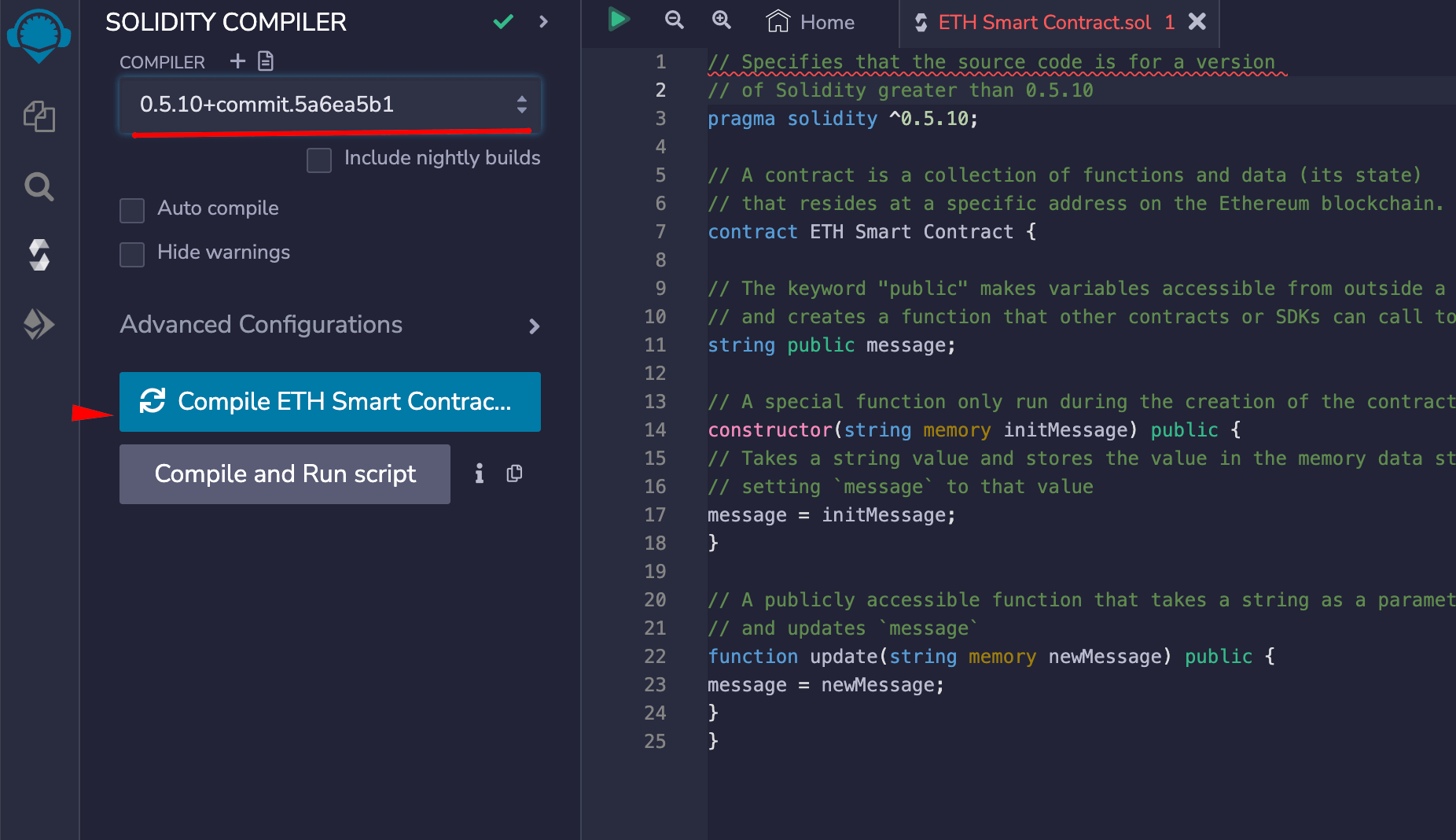
Step 4. Connect Your MetaMask to Remix IDE
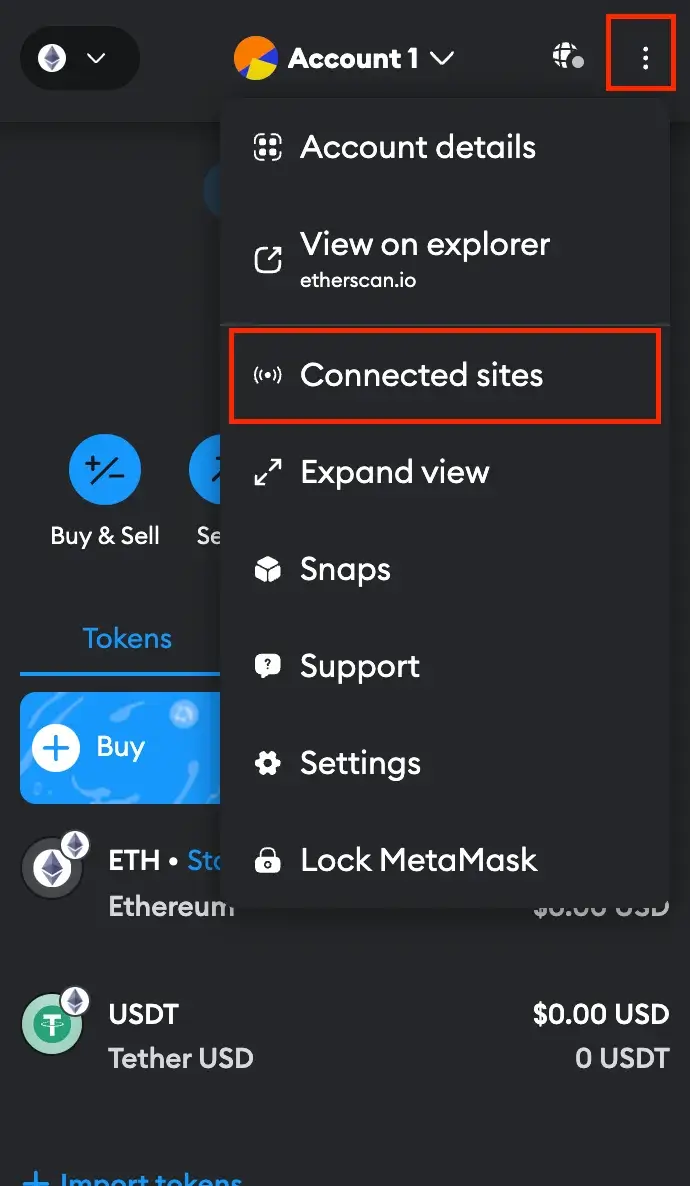
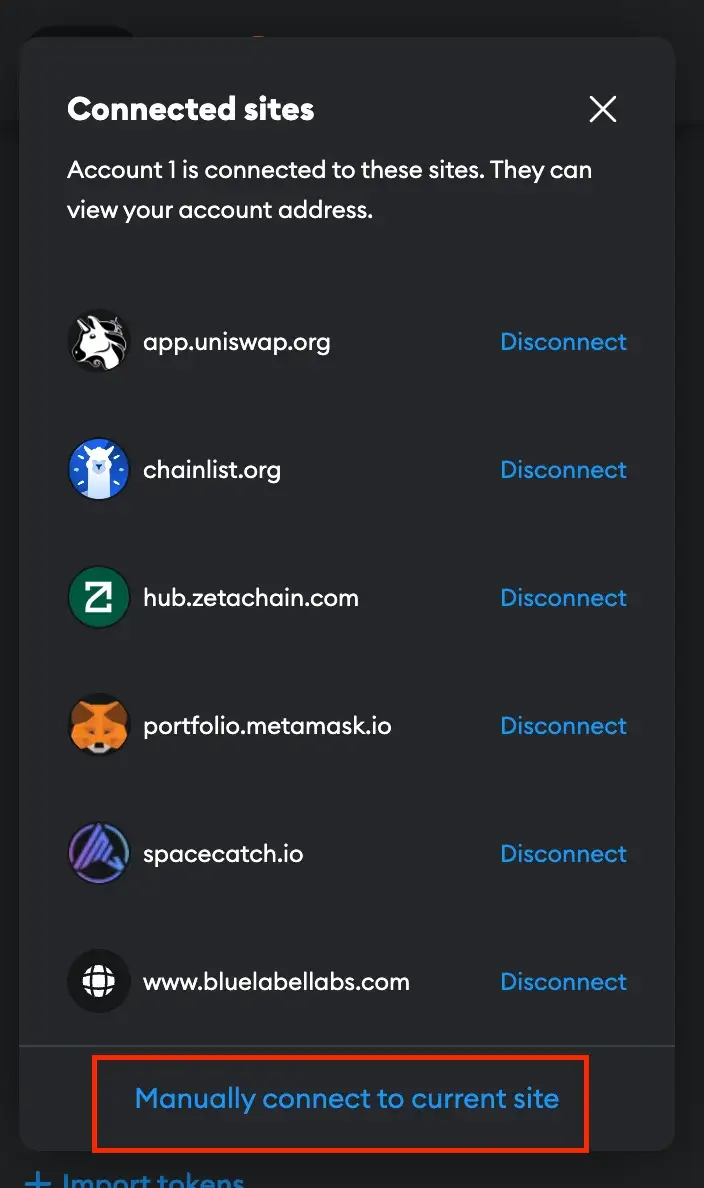
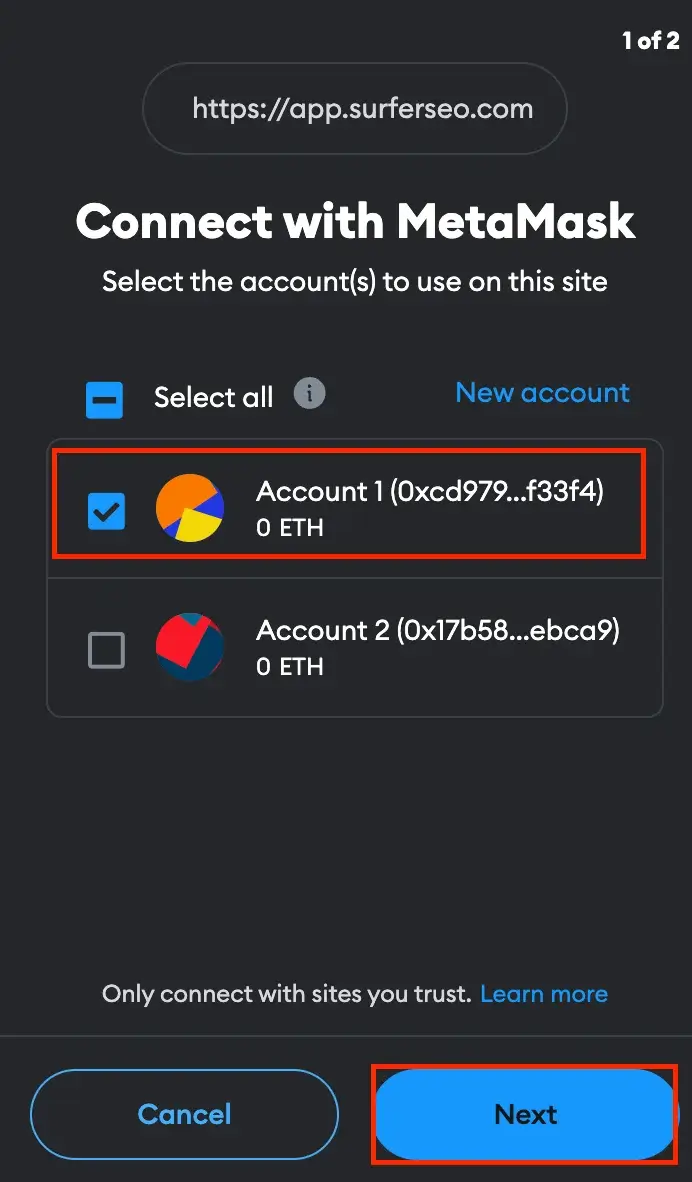
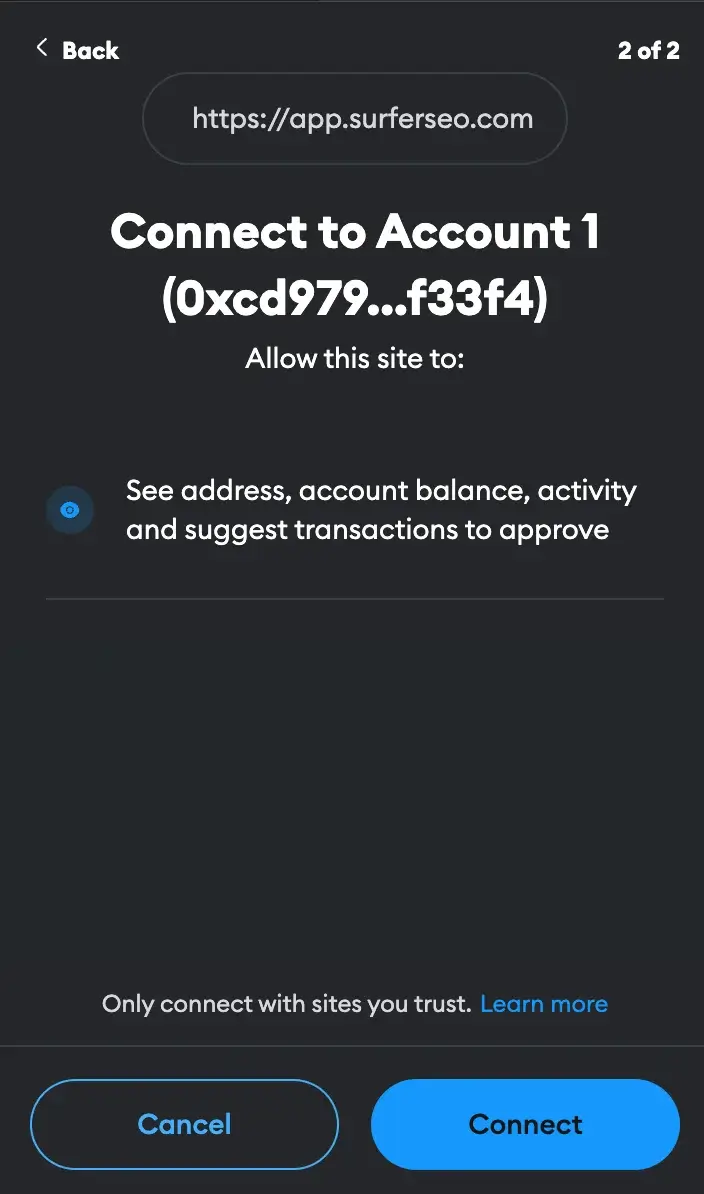
To integrate your MetaMask wallet with Remix IDE for deploying your smart contract, start by clicking the MetaMask icon in the toolbar, then select “Connected sites” from the options menu. Opt to “Manually connect to the current site” and choose the account. Proceed by clicking “Next” and then “Connect.” Upon successful connection, a small green circle will appear on your MetaMask wallet’s homepage, confirming its linkage to Remix IDE.
Step 5. Deploy Your Own Smart Contract
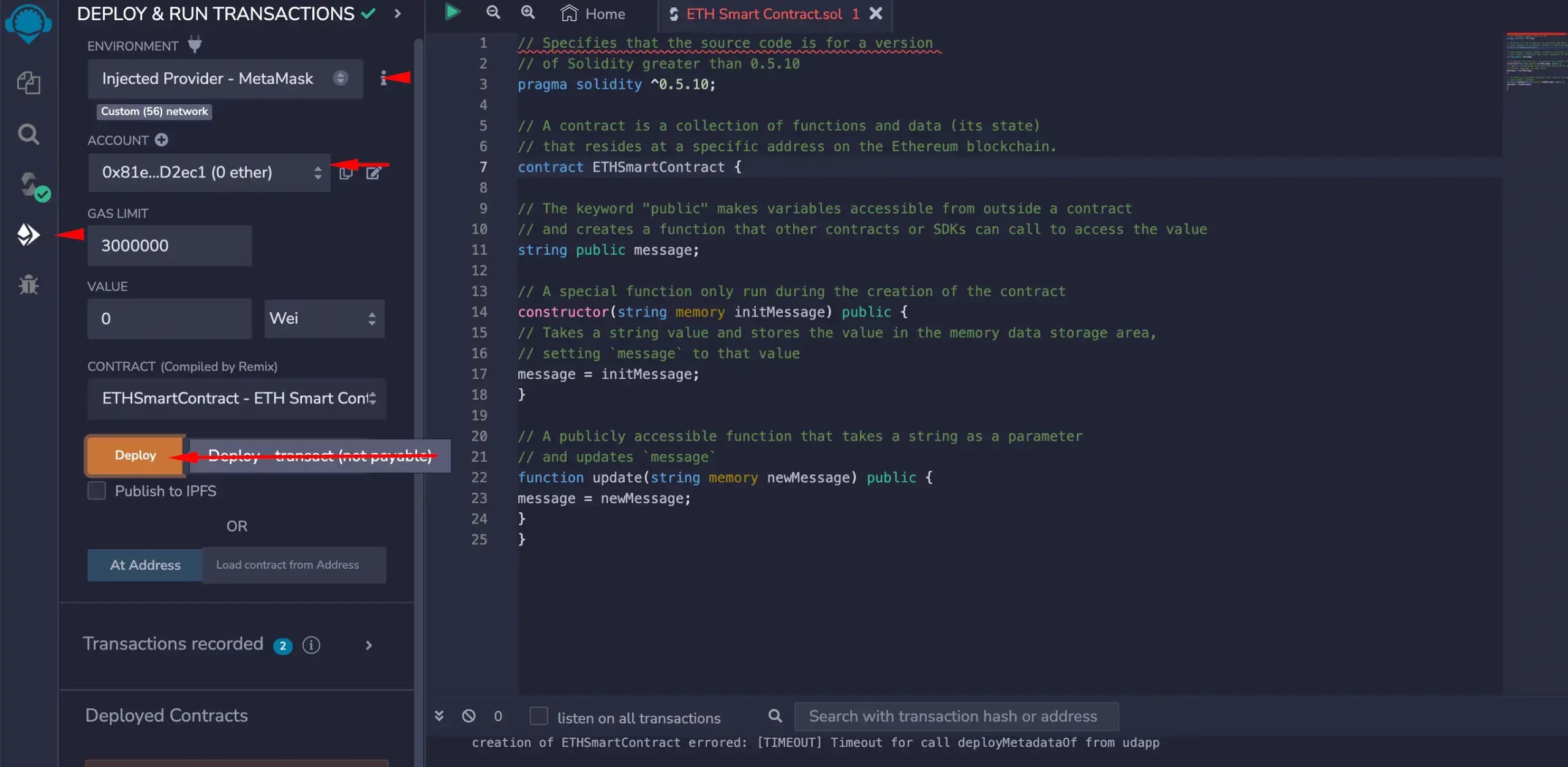
To proceed with creating smart contracts or deploying smart contracts, navigate to the “Deploy & Run Transactions” option in the left sidebar.
Then, click on the “Environment” drop-down menu and choose the “Injected” option. Subsequently, click the “Deploy” button below, triggering a pop-up window displaying the deployment transaction details.
Finally, confirm the transaction by clicking the “Confirm” button to execute the deployment process automatically. Now, you have a deployed contract.
What is a Smart Contract?
In 1994, the computer scientist Nick Szabo pinpointed the term “Smart Contract” for the first time when attempting to process a transaction using computerized transaction protocols and a distributed ledger. Contrary to some popular beliefs suggesting that the first smart contract was made once with the launch of the first cryptocurrency, Bitcoin, in 2009.
Nick Szabo introduced us to the concept and released the first smart contract in 1998 when he created the “Bit Gold” digital currency, defining smart contracts as computerized transaction protocol that executes the terms of a contract. Let us explain the process.
As we all know, a traditional contract, the physical one, involves two or more people. Now, imagine you wish to buy a vacation home. You must meet with the landlord, agree on the terms and conditions, and then execute the transaction via a third party. It could be a lawyer or a government figure of authority to mediate the process. Still, not only would this be much more expensive, paying the mediators’ fee, but it also increases the risk of fraud or theft.
Yet, instead of dealing with the landlord, all the paperwork, and the intermediaries, you sign a smart contract, and the job gets done in minutes: no other expenses than the required gas fee, no stress, and most importantly, higher security during and after the transaction.
A smart contract is a self-executing digital transaction protocol that verifies, controls, and executes the agreement’s terms and conditions if both parties meet the requirements. The data is embedded in a computerized software code and stored on the blockchain.
A self-executing contract binds two anonymous parties without needing a third party to conduct the deal. However, you need to understand a smart contract does not imply legal language, terms, or agreements. Instead, it contains hundreds of lines of code creating a complex algorithm based on simple functions, such as “If-Then-When,” like in software programming.
If I send 10000 BTC,
Then you will send the physical goods, the vacation home,
When both parties met the conditions.
Easy, right? And no need to worry. You do not need advanced programming skills to create a smart contract; in a bit, we will show you the step-by-step process.
How Does Smart Contracts Work?
The algorithm of a self-executing contract functions within a decentralized ledger, where each node of the blockchain stores the data just like a server would. The main difference is that you must trust the transaction’s intermediary or third party in a centralized exchange.
The self-executing contract is deterministic, meaning it will only perform the required actions if both parties meet the terms and conditions. Remember the “If, Then, When” example?
Smart contracts are autonomous and immutable. They run independently once deployed on the blockchain; no alternation can be made. However, they could only self-destroy by coding them from the beginning, replacing themselves once this is done.
The smart contract also ensures transparency due to the blockchain’s nature, offering security and letting you see and audit the code beforehand. Also, if you have a development team, manually going through the smart contract code is the best way to discover coding issues.
Let us explain the process to you in order to see what smart contracts offer:
- There are two people interested in buying and selling digital assets.
- Both parties enter the self-executing agreement upon writing all the conditions for the exchange in code.
- This code carries within the blockchain the requirements for the deal that both parties must agree on. The transaction is executed when both meet the criteria.
- The transaction is done securely and transparently, and due to the nature of a smart contract, this could not be tempered, altered, or distorted. Also, both parties, the buyer and the seller, could track the transaction. However, the identities are confidential.
That’s how smart contracts work. So, even though the self-executing contract is permanent and cannot be changed once created, they are customizable, meaning that other industries can benefit from it. Yet, this may raise concerns about the possible coding loopholes and, nonetheless, the human factor that could be biased.
Types of Smart Contracts and Capabilities
We’ve learned that smart contracts are immutable and transparent, and we can see their popularity rising. Thus, many types of it appeared, each of which has significance.
In the following paragraphs, we will take a deeper dive into the most important types of contracts. Please note each token has its smart contract, depending on which blockchain network has been created, but the most popular one remains Ethereum.
1. Token Deployment Smart Contracts
Since a token represents assets electronically within the blockchain, this could apply to services, money, memberships, and so on. Each token has its smart contract, written and scripted to perform specific actions, and it differs from one platform to another.
A token deployment smart contract is a self-operating contract developed to deploy and handle digital tokens on the blockchain.
These tokens can represent several types of assets, such as cryptocurrencies, utility tokens, security tokens, or non-fungible tokens (NFTs).
Nowadays, Ethereum is the most popular, but many other cryptocurrency blockchains, including EOS, Neo, Tezos, Tron, Polkadot, and Algorand, can run them.
2. The Smart Contract NFT
We have to give special attention to the Smart Contract NFT. Like cryptocurrencies, NFTs are digital assets; however, due to their nature as non-fungible tokens, they can be owned by only one person at a time. As the NFT is a unique digital asset, a smart contract implies the same self-execution agreement, as seen in the token deployment. Still, in our case, the NFT’s smart contract can only assign and reassign the ownership without involving a third party.
By minting an NFT, which involves converting pictures, videos, or other digital files into crypto assets, the smart contract gets automatically deployed into the blockchain. By minting, you are configuring the smart contract code that determines the qualities of your crypto assets.
Smart Contract NFTs have gained significant popularity in the digital art, collectibles, gaming, and entertainment industries, providing a means of tokenizing and trading unique digital assets. Self-executing contracts ensure the secure and transparent management of NFT ownership, transactions, and royalties, revolutionizing how digital assets are created, owned, and exchanged.
3. Application Logic Contracts
ALCs are another type of smart contract where the codes run on a blockchain network and implement specific business logic or rules for decentralized applications (DApps).
How do the ALCs work? Application Logic Contracts provide transparency, immutability, and trust in the execution of decentralized applications. They enable the creation of self-executing, tamper-proof, and auditable applications that operate without centralized intermediaries.
4. Decentralized Autonomous Organizations
We all know that DAO represents a community with no central leadership. Instead, the decisions are made from the ground up. An organized group governs DAO around a specific set of rules enforced on a blockchain.
How Does a Decentralized Autonomous Organization Work? DAOs operate based on smart contracts, enabling processes without human intervention. Smart contracts are lines of code instructing the next course of action whenever the criteria are met, and they get deployed on multiple blockchains.
These smart contracts determine the rules for the DAOs, and those with a stake get voting rights over the organizations’ operations and processes. For a proposal to be accepted and implemented, it must pass most stakeholders, and how this gets done can be specified within the smart contract.
What Smart Contract Platforms are Available in Crypto?
As any developer could create and deploy smart contracts within the blockchain, this influenced the emergence of on-chain verticals such as NFTs, blockchain gaming, and many more, leading to an explosion of smart contract platforms.
With the launch of Bitcoin in 2009, a set of rules needed to be honored for the bitcoins to be transferred from one address to another. While this was designed with a single focus, it was initially called a “Protocol Smart Contract.” Only after a couple of years did Bitcoin developers integrate more functionalities like the smart contracts with which we are all familiar.
Another significant step was developing the blockchain to operate as a platform for programmable smart contracts, leading to the launch of Ethereum in 2015, the first blockchain that could act as a platform for self-operating contracts.
Keep reading further to discover the five most popular smart contract development platforms.
1. Ethereum Smart Contract
Ethereum is a well-known and widely used smart contract platform. It introduced the concept of smart contracts and has a robust ecosystem of decentralized applications (Dapps) and tokens. Ethereum’s native programming language is Solidity, a statically typed, object-oriented programming language designed specifically for EVM (Ethereum Virtual Machine).
Solidity compiles into bytecode, which is easier for the Ethereum Virtual Machine to run and interpret. Several other platforms, such as Polygon and Avalanche, support the EVM nowadays, thus, reinforcing that smart contracts written in Solidity are accessible.
2. Polygon Smart Contract
Polygon, formerly known as Matic Network, is a layer two protocol framework for building an interconnected blockchain ecosystem that was launched in 2017. The DeFi network helps scale the Ethereum ecosystem, being compatible with the Ethereum Virtual Machine; therefore, deploying a smart contract written in Solidity is possible.
3. Cardano Smart Contract
Cardano could be considered one of many rivals of Ethereum, known for its focus on security and scalability. In this instance, the smart contracts act as an executable program on its network. It employs a proof-of-stake consensus algorithm and uses Plutus, Marlowe, or Glow programming language for smart contract development.
4. Solana Smart Contract
Solana is a performant blockchain platform that strives to provide fast and scalable Dapps. It supports self-executing contracts written in Rust, C, and C++.
5. Tron Smart Contract
Tron is another excellent example of a platform that focuses on providing high-speed and low transaction fees. It supports a multi-language environment, sustaining smart contracts through its Virtual Machine (TVM).
Java, Python, Objective C, and C++ are just a few languages Tron supports.
These are just a few examples of the many smart contract platforms available in crypto. Each platform has features, performance characteristics, and development ecosystems catering to different use cases and developer preferences.
FAQ
How to Create a Smart Contract on Ethereum?
To create a smart contract on Ethereum, follow these steps:
- Set up your development environment by opening Remix-IDE in your web browser. Then, navigate to the “Contracts” tab and create a new file for your smart contract code.
- Copy and paste the provided Solidity code into the code editor.
- Compile the smart contract by selecting the Solidity Compiler option and clicking the “Compile ETH Smart Contract” button. A green tick mark will appear if the compilation is successful.
- Connect your MetaMask wallet to Remix IDE by clicking the MetaMask icon, selecting “Connected sites,” and manually connecting to the current site. Once connected, a small green circle will indicate the connection.
- Deploy your smart contract by navigating to the “Deploy & Run Transactions” option. Choose the “Injected” environment from the drop-down menu and click the “Deploy” button. Confirm the deployment transaction, and your smart contract will be deployed on the Ethereum network.
What are the Best Smart Contract Platforms?
The best platforms for your smart contract are Ethereum, Polygon, Cardano, Solana, and Tron.
What are the Best Smart Contract Languages?
Solidity is the most popular, followed by Haskell’s programming language, Rust, Java, Python, Objective C, C++, Plutus, Marlowe, and Glow.
Last Thoughts
Whether you want to know a smart contract and its capabilities, the types of self-executing contracts, or how to create a smart contract, we hope this article provides you with the most important aspects that hopefully will change how we conduct any transactions.
In addition, you can now create your first smart contract without needing the help of an external mediator. You are deploying your self-executing contract with just a few clicks and in minutes.






